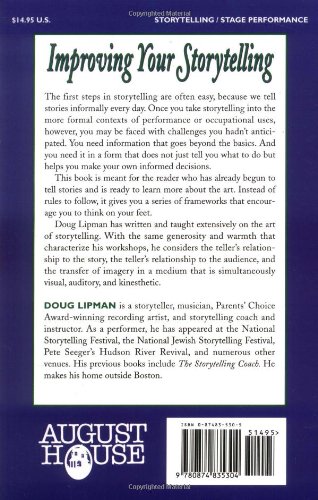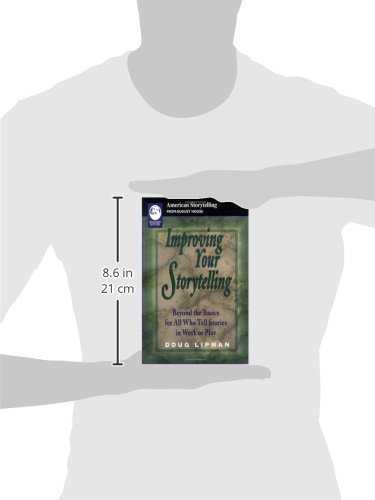Customer Services
Copyright © 2025 Desertcart Holdings Limited
Desert Online General Trading LLC
Dubai, United Arab Emirates




Improving Your Storytelling: Beyond the Basics for All Who Tell Stories in Work and Play (American Storytelling)
A**R
Going beyond the basics
This book by Doug Lipman starts off in the introduction by reminding us that there is no right way of telling a story, for me, a people pleaser, this is a great way to start off this particular book. He put me at ease telling his readers that we can be who we are while telling our stories and there is no right or wrong way to do it. He then talked about how to be present, be in the here and now while telling your story to make it real to you and the people who are listening, which in my opinion helps set the stage of mindset before even telling your story.The first chapter is about oral language and how to use your strengths and weaknesses while telling your story. He goes on to teach about facial expressions, gestures and posture. In this chapter he writes about eye behavior, I thought that it was a little much to tell his readers that this did not matter as just a few pages ago he told us there was no right or wrong way. I know for me I care a lot about eye behavior and that is how I get most of my laughs while telling a story, maybe for him personally this has never mattered. Also in this chapter he wrote about the ever important pausing, which I believe is a very important thing to learn about in our storytelling journey. Something in this first chapter that has really improved my storytelling was the idea of making your stage uncrowded. This is a very wise thing that he has taught his readers as it is very hard to tell a multi-person story, it is simpler to tell your story with as few characters as possible.Chapters two and three are about imagery and the power of images in your story. If you as the audience will take the journey with him in hearing, seeing and smelling the things he asks you to, you will not be disappointed, thank you for the journey, Lipman! While some may feel as these two chapters went too deep, I loved getting pulled that deep into the story and all the possibilities that a story could have with more than just words.While chapter four is probably an important chapter for many, it was not as thrilling and touching as the last two for me. I did enjoy learning especially about the difference in how men and women hold themselves, but I thought it was too much body positioning talk to me as that for me is not as important to the story as the senses, expressions and tone.Chapter five starts to put together the real meat of your story; I found chapters five through nine to be incredibly helpful to learn to tell a story. When we have a story to tell, it is important to think about the most important thing in your story. It is very interesting and fun for me to think about this before telling a story, not just for the mental exercise it brings but to dig deep into every nook and cranny of my story to flush out the most important thing in it. I think that these chapters really express the subtitle of this book, going beyond the basics of storytelling. He invites you to find creativity in your story and to personalize your story in a way that I have never had the opportunity to do.While I appreciate the rest of the book; chapters ten through nineteen; I had a very hard time understanding how those of us who only tell stories for fun would benefit as much from them. I can absolutely see how these chapters are extremely important for those whose paychecks are on the line for their stories, but for those of us who do it only for play I felt like this second half of the book would have been a wonderful second book for the person looking to go into extreme depths of storytelling.Overall I thought his writing style was easy to read and very helpful for anyone wanting to improve their storytelling.
K**6
A book that offers clear insight to improve all manner of storytelling
One of the great books of storytelling improvement. The chapters don't say more than what they need to, but they don't say less either. The points are very clear and very concise, with Lipman offering various strategies to improve a person's dialogue, you would think that individuals would become lost in the text. Lipman, however, writes in a way that caters to the individual. If a thesis or main point could be made about the book, it would be that Lipman helps the individual create his or her stories based around the Most Important Thing (MIT). Learning the most important thing a storyteller wants to get across to his/her audience is the foundational step to building an excellent storytelling event. This insight is crucial because it creates a sense of focus about the story and gives it a direction. Is the MIT of the story to teach a moral lesson, or is it purely for entertainment purposes, is it to grip the hearts of others so that they will contribute to a cause? These are the things a person can expect to learn throughout this book with a step by step process.Lipman offers these insights through experience, being one of the foremost storytellers in the United States (perhaps farther), Lipman demonstrates excellent knowledge with easy to follow steps toward enhancing one's ability to tell stories. I would have given this book five stars but there was one thing that stuck out, that was missing, that I wish Lipman had added to the book. Lipman mentions three building blocks that make up storytelling, one of which he chose not to include in the book. "To understand the storytelling event, look at its major components. One is the transfer of imagery that occurs, and its building blocks: oral language and images. A second, not dealt with in this book, is the context of the event, the physical and social setting in which a story is told. Finally, there are three obvious ingredients: the storyteller, the audience, and the story. These three form the corners of a triangle-the storytelling triangle" (Kindle, Loc. 143). Including this may have made the book become too great in length, but I would opt for its inclusion to increase length and then let the reader choose whether or not to absorb this material.Because storytelling is an art form, it is difficult to debate Lipman's methods for creating a story from the MIT to the execution and close. However, it can be said that I have read other books regarding self-development, dialogue, and interpersonal communication and Lipman's suggestions seem to expand upon those concepts. For example, the "attention getter" that we are taught in speech class, Lipman expands it further, making it individualized. For Lipman, personally, he uses music for the attention getter, or, invitation, as he states it. He further cites other storytellers and their individual methods based on their personalities. This book truly caters to developing one's own sense of storytelling style.
W**W
Five Stars
5*
B**I
Five Stars
Brilliant, what more can I say
A**J
Great for improving your storytelling skills
Over the last 2 years I have started to develop my storytelling skill.s I absolutely loved this book. There was hardly a page I did not learn something from. It is written in a very accessible style with many examples to illustrate the points being made.It is divided into 3 parts looking at the 3 keys aspects of storytelling, according to the author and at the end he brings the 3 sections together.I read this cover to cover and is definitely a book I will return to.
S**S
Great book - just what I was after
Good tips to improve your story telling
J**Z
My favorite book about storytelling, and more
I learned a lot from Doug Lipman's book, "Beyond the Basics" of storytelling,not only to tell stories better, but understanding a lot better the relation between the triangle "story" (or speech), the teller, and most important the audience.A lot of details I incorporated in my humorous speeches - in fact all stories, and till now I read and studied it three times, each time discovering new jewels.I do not know, or understand from where arrived suddenly the sub title "American storytelling" - it is Universal!
Trustpilot
1 day ago
3 weeks ago